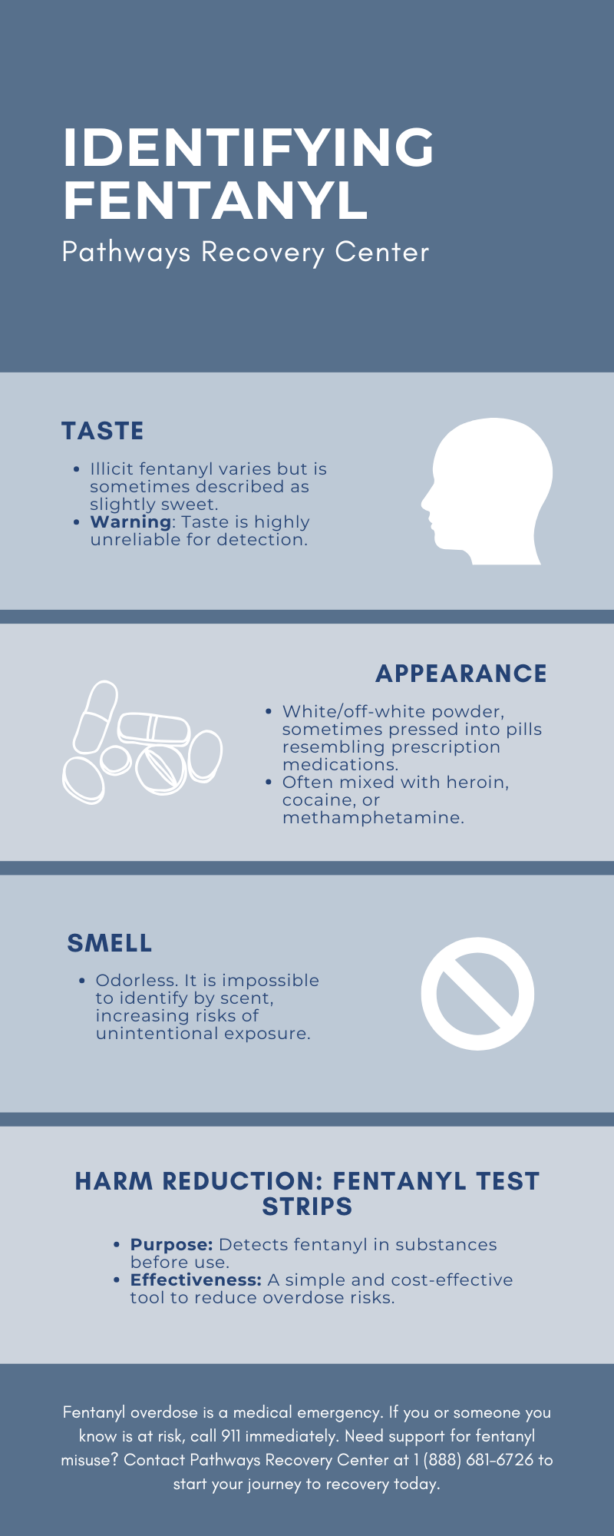Fentanyl is a synthetic opioid up to 100 times stronger than morphine, widely used in medical settings for severe pain management, but also prevalent in illicit drug markets. According to the CDC, fentanyl has been implicated in about 75% of opioid-related overdose deaths in the U.S. in 2021, often because it is mixed with other drugs like heroin or cocaine without users’ knowledge. Due to its varied forms and potent effects, fentanyl can be difficult to identify by sight, as it typically appears as a white or off-white powder, much like other drugs. Additionally, fentanyl lacks a distinct taste or smell, making sensory detection methods highly unreliable and risky.
Given these challenges, fentanyl test strips are recommended as a safer alternative for detecting the presence of fentanyl in substances. These strips can provide a crucial tool for reducing overdose risks by allowing users to check drugs before consumption. Its high potency means that even minuscule amounts can trigger severe responses, including overdose, making its illicit use particularly hazardous. If you’re looking for information on how to get off fentanyl, Pathways Recovery Center offers specialized programs tailored to assist in safely discontinuing the use of this potent opioid. At Pathways Recovery Center, we emphasize the importance of professional treatment for individuals struggling with substance use involving fentanyl. Our comprehensive inpatient and detox services offer tailored support, helping patients navigate recovery in a supportive environment focusing on sustainable health and wellness.
What is Fentanyl?
Fentanyl is a synthetic opioid that was first developed in 1959, primarily for use in medical settings to manage acute and chronic pain, especially in cancer patients and during certain surgical procedures. Its potency, approximately 100 times greater than morphine, makes it a highly effective option for controlled pain management. However, this same potency also makes fentanyl highly susceptible to misuse and addiction. The illicit production and distribution of fentanyl have significantly exacerbated the opioid crisis. According to recent data, deaths involving synthetic opioids other than methadone, primarily fentanyl, continued to rise, with 70,601 overdose deaths reported in 2021. This alarming statistic underscores the dual nature of fentanyl as both a critical medication and a dangerous illicit substance. Often clandestinely mixed with other street drugs, fentanyl significantly increases the risk of overdose, as even small quantities can be deadly.
What Does Fentanyl Taste Like?
Fentanyl’s taste is not a reliable indicator of its presence. Illicit fentanyl may vary in taste depending on its formulation and what substances it has been mixed with. Some users report a slightly sweet taste, which contrasts sharply with the bitter taste of pure heroin. However, these sensory experiences are subjective and can vary widely, making taste an unreliable method for detecting fentanyl.
What Does Fentanyl Look Like?
Identifying fentanyl by taste is highly unreliable due to the variability in its formulations and the substances with which it may be mixed. Illicit fentanyl can range in taste, with some users describing it as slightly sweet—a stark contrast to the distinctly bitter taste of pure heroin. However, these sensory descriptions are highly subjective and inconsistent. The presence of fentanyl in a substance can alter its flavor profile unpredictably, depending on the chemical composition and purity of the batch. Consequently, relying on taste as a method to detect fentanyl is not only unreliable but also potentially dangerous, as the potency and effects of fentanyl do not correlate with its taste. This makes sensory detection an inadequate safeguard against the risks associated with unknowingly consuming this potent opioid. When comparing fentanyl vs. oxycodone, it’s important to note that fentanyl’s potency is significantly higher, making accidental overdoses much more likely when consuming unknown or mixed substances.

What Does Fentanyl Smell Like?
Fentanyl generally does not emit a distinctive odor, which makes it extremely challenging to identify by smell. This lack of a unique smell contributes significantly to the risks associated with fentanyl, particularly when it is illicitly mixed with other drugs. The absence of a recognizable odor means that individuals cannot rely on their sense of smell to alert them to the presence of fentanyl in a substance. This characteristic makes fentanyl especially dangerous because users may unknowingly consume it when it is combined with other drugs, increasing the likelihood of overdose without any sensory warning signs. Therefore, the odorless nature of fentanyl underscores the importance of chemical testing methods, such as fentanyl test strips, for anyone suspecting its presence in a substance.
Fentanyl Test Strips
Given the challenges of detecting fentanyl through sensory methods such as taste, sight, or smell, fentanyl test strips serve as a crucial tool for individuals who use street drugs. These strips are designed to detect the presence of fentanyl in various substances quickly and effectively. By providing a simple, discreet means of testing, fentanyl test strips empower users to identify fentanyl contamination before ingestion, significantly reducing the risk of unintentional overdose. Pathways Recovery Center strongly supports using these test strips as a comprehensive harm reduction strategy. The availability and utilization of fentanyl test strips are vital in preventing overdose deaths, especially in communities heavily impacted by the opioid crisis.
How Is Fentanyl Taken?
Fentanyl is administered in various medical forms, such as transdermal patches, pills, and injectables, which are designed to deliver controlled doses for managing severe pain. In non-medical contexts, however, fentanyl is misused much like other opioids—it can be injected, snorted, or smoked. Its high potency means that even minuscule amounts can trigger severe responses, including overdose, making its illicit use particularly hazardous. The risk is compounded when fentanyl is clandestinely added to other drugs, often without the user’s knowledge, increasing the likelihood of overdose due to its extreme potency compared to other opioids. Long-term misuse of fentanyl can also lead to severe dental decay, commonly referred to as fentanyl teeth, where users experience rapid tooth decay and loss due to the drug’s effects on oral health and hygiene. This underscores the importance of cautious handling and the potential dangers of fentanyl outside of prescribed and supervised use. Fentanyl is administered in various medical forms, such as transdermal patches, pills, and injectables. For those struggling with dependency on fentanyl, undergoing a detox from fentanyl is a critical first step, and our center provides a medically supervised detoxification process to ensure safety and comfort.
The Dangers of Fentanyl Use and How to Protect Yourself
Fentanyl’s potency and the risks associated with its illicit use make it one of the most dangerous drugs in circulation today. Due to its frequent use in counterfeit pills and other illicit drugs, many people unknowingly consume fentanyl, leading to unintentional overdoses. The misuse of fentanyl, whether in its powdered form or as fentanyl-laced marijuana, presents serious health risks, including overdose and death. Fentanyl withdrawal can also be particularly severe, making professional opioid addiction treatment critical for those looking to detox and recover.
One of the best ways to mitigate the dangers of fentanyl is through the use of fentanyl test strips, which can detect the presence of fentanyl in substances like counterfeit pills. These strips, alongside medically supervised detox programs, can save lives by preventing the accidental consumption of fentanyl-laced drugs. In communities plagued by substance abuse, including opioid use disorder and synthetic opioid addiction, counterfeit pills containing fentanyl are increasingly common. Therefore, anyone involved in drug use needs to be aware of the risks of fentanyl contamination in illicit drugs.
If you or a loved one is battling fentanyl addiction, professional treatment is available. At Pathways Recovery Center, we offer comprehensive addiction treatment programs that address opioid overdose, opioid use, and other aspects of substance abuse. Our services include medically supervised detoxification for fentanyl, synthetic opioids, and other drugs, ensuring a safer recovery process.
Inpatient Addiction Treatment and Detox at Pathways Recovery Center
Recognizing the signs of fentanyl use is just the first step. Addressing fentanyl or any substance addiction requires comprehensive treatment. Pathways Recovery Center offers specialized inpatient addiction treatment and detox services designed to help individuals overcome addiction in a supportive and healing environment. Our programs are tailored to meet each patient’s unique needs, incorporating medical detoxification and a range of therapeutic modalities to support long-term recovery. Recognizing the signs of fentanyl use is just the first step. Addressing fentanyl or any substance addiction requires comprehensive treatment. Learn more about our opioid addiction treatment programs, which are designed to support long-term recovery and help individuals regain control over their lives.
If you suspect that you or someone you love is dealing with substances potentially laced with fentanyl, it’s crucial to seek professional help. Contact Pathways Recovery Center to learn more about our programs and how we can assist you in taking the first step toward recovery. Our dedicated team supports you 24/7 in achieving a healthier and drug-free life.






